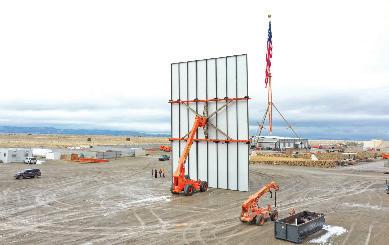
3 minute read
MINING CENTRAL TO IRON COUNTY SINCE COUNTY’S SETTLEMENT
Iron ore, mining and metal have been central to Iron County since its beginning, even providing the county with its name, and its residents continue building on that legacy today.
In the 1840s, members of The Church of Jesus Christ of Latter-day Saints exploring Southern Utah discovered the Little Salt Lake (Parowan Lake) area contained immense quantities of iron ore as well as thousands of acres of juniper trees that could provide fuel.
In January 1850, the General Assembly of Deseret, a proposed state at the time, created six counties, one of which was named Little Salt Lake County. Before the end of that year, the county was renamed Iron County to reflect its reserves of iron ore.
A call went out from the LDS Church for volunteers to move to the area to be part of the “Iron Mission.” The volunteers were asked to build a settlement and establish an iron foundry as soon as possible.
Two companies of wagons left Provo on Dec. 16, 1850, to travel to the Iron Mission. The first settlement was created where Parowan is now located.
In November of 1851, a group of these pioneers left Parowan and traveled 20 miles south to establish Cedar City, which was named after the many juniper trees in the area that were mistakenly called cedars.
The plan was to center iron manufacturing in this new area, and work commenced in building the community and the infrastructure for manufacturing iron, including a blast furnace. In late September of 1952, the first iron was produced.
The iron industry suffered setbacks in the coming years. The years 1855, 1856 and 1857 were disastrous, with grasshoppers and other pests destroying crops and the winters being cold and long as opposed to the prior milder winters. Some iron was produced and some items made.
Also, the arrival of Johnston’s Army in the Utah Territory in 1858 brought great stores of goods to the territory, including iron tools, wagon wheels and other implements, which ended the pressing need for iron production. In October 1858, Brigham Young issued orders for the iron works to be closed down. The Iron Mission was ended without producing iron of a quantity and quality needed for the pioneer effort, not because of lack of commitment from those sent there to produce it, but from outside circumstances beyond their control.
Around 1868, several men established a private iron production enterprise on a site about 20 miles west of Cedar City. This iron works produced pig iron for stoves, Dutch ovens and other household items as well as for machinery used in Nevada mines. This effort lasted into the 1880s.
Various efforts were made to mine and produce iron as the turn of the century came and went. These efforts were aided as the railroad came to Cedar City and production facilities were created elsewhere in Utah. By April of 1924, coal and iron were being shipped to a blast furnace created by Columbia Steel in Provo.
Millions of tons of iron ore were mined in the county and shipped to other locations during the next few decades. The number of mine workers increased even more when the Geneva Steel mill was constructed in Utah County and Iron County began supplying it with ore.
Old Iron Town
Those interested in learning more about Iron County’s mining history can visit Old Iron Town, the home of a former iron factory. Visitors can view ruins of structures used to produce iron in the late 1800s, including a preserved beehive-shaped charcoal oven. The area also features a nature trail and informational plaques. Old Irontown is located nearly 24 miles southwest of Cedar City via Highway 56.
The Iron County mining industry took a major hit when Geneva Steel closed in 2002. However, interest in mining has been increasing again in recent years.
Iron County’s economy has diversified, but some local companies continue finding success in the metal industry. One of these is BZI Steel, a leading innovator in steel fabrication and erection as well as insulated metal panel wall installation. Specializing in large warehousing construction projects, BZI works in partnership with major retail, distribution and industrial clients across the United States and internationally.

Headquartered in Kanarraville, Building Zone Industries was established in 2016 with a mission to revolutionize the steel construction industry through innovation, team performance and accelerated project delivery while setting new standards in safety and efficiency. Its fabrication facility can produce approximately 2,500 tons per month of finished steel product.
The company has seen significant growth since its founding, with its patented and proprietary construction equipment, exclusive innovations and processes in steel erection and fabrication, wall panelization and roofing systems resulting in the company growing its revenue more than tenfold and employee base to more than 450 in only five years.
Increased efficiencies resulting from BZI innovations are allowing the company to consistently raise more than 2.5 million square feet of steel each month. Since 2017, BZI has installed more than 105.7 million square feet in building space.
BZI’s one-of-a-kind building equipment, innovative practices and exclusive SteelTech Academy — a safety, training and certification program for all its team members and other industry companies — are attracting the world’s most renowned businesses and retailers and biggest general contractors as customers, improving


